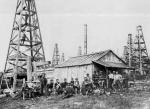Chapter Two: Boom and Bust
In 1864, an actor whom many people then considered among the handsomest men in the United States speculated in the oil fields of northwestern Pennsylvania. John Wilkes Booth was intrigued by the get-rich quick possibilities. He formed an oil company with several partners and stayed in nearby Franklin for a time. Booth's tenure in the oil fields was short, however. His acting career and obsession with the politics of the Civil War drew him away. In April 1865 Booth solidified his role in history by assassinating President Abraham Lincoln at Ford's Theater in Washington, D.C. Like many other Americans, Booth was allured by the possibilities of wealth in Pennsylvania's oil region. The oil business was wide open, especially for those determined to strike it rich.
In the oil fields, so-called "boomers" found several opportunities for investment. Before 1865, the industry's governing principle was the rule of capture. That meant that since there was no property law governing underground crude, as it was a liquid resource, the first one to strike and seize the supply was the winner of the fortune. Once the oil flowed to the surface, it became the property of the landowner. The rule of capture stimulated rapid growth. Enticed by the imaginings of riches "boomers" flooded the area, creating a unique culture. The development of new technologies, such as the Roberts Torpedo, accelerated the flow of oil.
Roberts Torpedo, accelerated the flow of oil.
Oil speculation spawned other industries including those that were a bit more leisure oriented. Barrooms, brawlers, and brothels became the stuff of local and national legend. The exploits of prizefighter Ben Hogan or brothel manager "French Kate" grew to become popular stories in articles and books. These tawdry characteristics made one place in particular, Pithole, distinct. Americans either loathed the immorality of the boomtown or they wished to visit it. Either way, people loved to read of Pithole and its drama in popular literature.
Boomtowns were central to the development of the oil industry that had expanded after the mid-1860s to include far-flung places like Midland, Texas, Casper, Wyoming, and Talara, Peru. Its roots, however, could be traced back to the Oil Creek valley and Pithole and
Pithole and  Pithole City. Typically the birth of boomtowns arose around the possibility of production wells such as the
Pithole City. Typically the birth of boomtowns arose around the possibility of production wells such as the  Gantz Oil Well, and the first "dry hole",
Gantz Oil Well, and the first "dry hole",  Grandin Well, which demonstrated the risks and failures associated with speculation. Model towns developed in the oil region including one named for
Grandin Well, which demonstrated the risks and failures associated with speculation. Model towns developed in the oil region including one named for  Henry Rouse, a former teacher and Warren County legislator who became a successful oil lease owner.
Henry Rouse, a former teacher and Warren County legislator who became a successful oil lease owner.
Boomtowns reflected the oil industry's primary characteristic: mobility. As they followed the oil frontier around Venango County, the success or failure of oil strikes was demonstrated in population trends. Oil Creek Township had no population in 1860, over 5,000 in 1870, then 526 in 1880. A town named Cornplanter boomed from 1,000 occupants in 1860 to nearly 10,000 in 1870. Pithole City, the prototype boomtown community, rose from non-existence in 1860 to over 10,000 in 1865 then fell to 237 in 1870, and ceased to exist by 1880.
As with many industrial enclaves, towns like Pithole were planned with surveyed streets and lots. The Titusville Morning Herald covered the development of the town of Shamburg in 1867. The town was the dream of Dr. G. S. Shamburg and lay 1.5 miles by stagecoach from the nearest railroad connection. It consisted of one church, two schools, one post office and three telegraph offices. The paper's description of the town sought to enlist new investors and inhabitants. Those in the Pennsylvania oil fields, otherwise known as "Petrolia", speculated about the next frontier. New towns, like Shamburg, seemed to spring up overnight, only to be abandoned during the 1870s when the supply of oil dwindled.
In the oil fields, so-called "boomers" found several opportunities for investment. Before 1865, the industry's governing principle was the rule of capture. That meant that since there was no property law governing underground crude, as it was a liquid resource, the first one to strike and seize the supply was the winner of the fortune. Once the oil flowed to the surface, it became the property of the landowner. The rule of capture stimulated rapid growth. Enticed by the imaginings of riches "boomers" flooded the area, creating a unique culture. The development of new technologies, such as the
Oil speculation spawned other industries including those that were a bit more leisure oriented. Barrooms, brawlers, and brothels became the stuff of local and national legend. The exploits of prizefighter Ben Hogan or brothel manager "French Kate" grew to become popular stories in articles and books. These tawdry characteristics made one place in particular, Pithole, distinct. Americans either loathed the immorality of the boomtown or they wished to visit it. Either way, people loved to read of Pithole and its drama in popular literature.
Boomtowns were central to the development of the oil industry that had expanded after the mid-1860s to include far-flung places like Midland, Texas, Casper, Wyoming, and Talara, Peru. Its roots, however, could be traced back to the Oil Creek valley and
Boomtowns reflected the oil industry's primary characteristic: mobility. As they followed the oil frontier around Venango County, the success or failure of oil strikes was demonstrated in population trends. Oil Creek Township had no population in 1860, over 5,000 in 1870, then 526 in 1880. A town named Cornplanter boomed from 1,000 occupants in 1860 to nearly 10,000 in 1870. Pithole City, the prototype boomtown community, rose from non-existence in 1860 to over 10,000 in 1865 then fell to 237 in 1870, and ceased to exist by 1880.
As with many industrial enclaves, towns like Pithole were planned with surveyed streets and lots. The Titusville Morning Herald covered the development of the town of Shamburg in 1867. The town was the dream of Dr. G. S. Shamburg and lay 1.5 miles by stagecoach from the nearest railroad connection. It consisted of one church, two schools, one post office and three telegraph offices. The paper's description of the town sought to enlist new investors and inhabitants. Those in the Pennsylvania oil fields, otherwise known as "Petrolia", speculated about the next frontier. New towns, like Shamburg, seemed to spring up overnight, only to be abandoned during the 1870s when the supply of oil dwindled.









